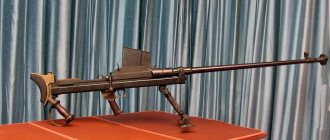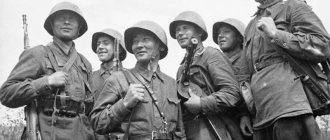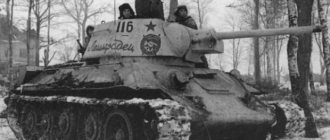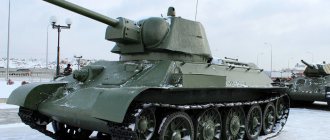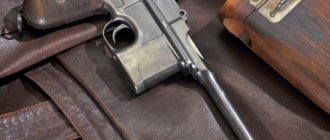When excavating at battle sites, German 8 cm mortar mines are often encountered. Used when shooting from Gr. W. 34 (81 mm mortar model 34) everywhere. There are several types of 8cm mortar mines:
- 81-mm fragmentation mine model 34 8 cm Wgr. 34
- 81-mm fragmentation mine model 38 8 cm Wgr. 38
- 81 mm fragmentation mine model 39 (bouncing) 8 cm Wgr. 39
- 81 mm smoke mine model 34 8 cm Wgr. 34 Nb.
- 81 mm mine for indicating targets model 38 8 cm Wgr. 38 Deut.
- 81-mm practical (training) mine model 34 8 cm Wgr. 34 Ub.
About fuses and detonators of mortar mines here
sample 34 "8 cm Wgr. 34"
It was equipped with cast TNT without a case or cast ammatol 40/60 without a case. The weight of the explosive is 460 grams. The body of the mine is painted red. Some mines do not have a igniter; such mines are marked with the letters “o. B."
Mine weight 3.5 kg. Length: 33cm. Initial speed: 211m/s. Flight range: 0.8 km to 3.1 km.
Fuses and detonators:
With 8cm fragmentation mine Wgr. 34 fuses used: Wgr. Z. 38, Wgr. Z. 34, Wgr. Z. 38 St., Wgr. Z. 38 C, Wgr. Z. 38 T.
Disassembled plastic fuze Wgr.ZT
Aluminum fuze Wgr.Z.38
Detonators
:
gr.
Zdlg. c/98 Np. (ten) or
gr.
Zdlg. c/98 H. (RDX) or
gr. Zdlg. c/98 H. oV
Disassembled Gr.Zdlg detonator. from an 8cm mortar shell
Explosive charge:
Stabilizer and markings on the ejector (tail) cartridge
The main charge is the tail cartridge “patrone des s. Gr. w 34 (8cm) 10g Ngl. Bl. P. 12.5-(0.1-0.1-0.2)" consists of 10 grams of nitroglycerin flake powder.
Pack of one hundred exploding cartridges for 8cm mortar mines
Additional (variable) charges Teilkartuschen, Zusatzladung:
To increase the firing range, an additional charge was placed on the mine between the body and the stabilizer
Teilkartuschen additional charge was supplied in a box along with the mines, packed in an aluminum or zinc round box. Each mine was supplied as standard with two charges - ring-shaped bundles of gunpowder.
Zusatzladung - additional charge (additional equipment, above the norm). Supplied when there was a shortage of additional charges complete with mines.
. Five combinations of charges were used for firing.
The first is the tail cartridge.
Second tail cartridge and one additional charge bundle.
The third is a tail cartridge and two additional charge beams.
The fourth charge is a tail cartridge and three beams.
The fifth charge is a tail cartridge and four bundles of additional charge.
Bundles of additional charge are attached to the tail of the mine and are ignited from the tail cartridge through the “fire transfer” holes. When shooting at night, flame arresters made of potassium sulfate weighing 10 grams are used.
Zusatzladung jar with markings
Ring bun Zusatzladung
Powder rings without braid
Marking of an additional charge for an 8cm mortar mine. Packaging of an additional Teilkartuschen for a German mortar mine.
A bakelite jar made from a flame arrester that was added to the charge to reduce the flash of a shot during night shooting. The inscription on the can is short for Kart. Worl. = Kartuschvorlage (charge flash suppressor
German mortar mine 8 cm WGr38
Soviet mortars during the war. Part 1
Mortars as a means of “trench warfare” appeared during the First World War. The main features of a modern mortar were formed when the first example of such a weapon, designed by Stokes, was created. At first glance, this is a rather primitive weapon, consisting of a pipe-barrel on a simple two-legged carriage resting on a flat plate that dampens the recoil force into the ground.
The 3-inch mortar designed by Captain Stokes in the “imaginary triangle” pattern, which has become classic, was created in 1915 and was originally intended to fire unfeathered chemical mines.
Chemical mortar fluff mine
When it hit a target, such a mine would fly apart, scattering toxic substances. Subsequently, mortar mines were created, filled with explosives, streamlined in shape, equipped with a tail.
In fact, the caliber of the “three-inch mines” was 81 mm, since the diameter of the covers at the front and rear of the cylinder is 81 mm. A hollow tube of smaller diameter than the mine was attached to the bottom of the mine - a chamber with fire-transmitting holes. A blank 12-gauge rifle cartridge in a cardboard sleeve was inserted into the tube. Additional ring-shaped powder charges were placed on top of the chamber. The firing range depended on the number of rings, although when firing at a minimum distance, the mine could be used without them.
The mine was loaded from the muzzle. The mine had a smaller diameter than the caliber of the barrel and fell freely to the bottom of the channel under the influence of gravity. The mine collided with the firing pin, and the igniter cap of a hunting cartridge inserted into the chamber was triggered. The ignited gunpowder, burning, developed a pressure sufficient for the powder gases to pierce the shell of the cartridge opposite the fire-transmitting holes. At the same time, additional charges were ignited. Under the pressure of powder gases, the mine was thrown out of the barrel.
Thanks to the ease of loading, a rate of fire that was enormous at that time (25 rounds per minute) was achieved, which no mortar or field gun had. Firing accuracy, especially with unfeathered chemical mines, was mediocre, which was compensated by a high rate of fire.
In the 20-30s, the mortar was significantly improved in France by specialists. The mortar has become lighter, maintenance and shooting from it have become significantly easier. Guiding the elevation angle in a small sector was carried out using a screw rotary mechanism located on the sight mount. New, heavier, streamlined mines were developed, in which not only the mass of the charge increased, but also the flight range.
The 81-mm Brandt mortar model 27/31 was widely used and became a role model. Mortars of this type were produced under license or simply copied, including in the USSR.
Before the war, there was an excessive passion for mortars in the USSR. The military leadership believed that light, inexpensive, easy to manufacture and maintain mortars could replace other types of artillery weapons.
Thus, under pressure from the “mortar lobby,” projects for light infantry howitzers were buried, and the Taubin automatic grenade launcher, which had proven itself well in tests, was not adopted for service.
At the end of 1939, the simplest type of mortar was created - a 37-mm minimum caliber shovel mortar. They were planned to replace the Dyakonov infantry rifle grenade launcher.
In the stowed position, the mortar weighing about 1.5 kg was a shovel, the handle of which was the barrel. The shovel mortar could be used to dig trenches. When firing a mortar, the shovel served as a base plate. The shovel was made of armored steel.
The mortar consisted of a barrel, a shovel - a base plate and a bipod with a plug. The barrel tube is tightly connected to the breech. A firing pin was pressed into the breech, onto which the capsule of the mine's expelling cartridge was placed. The tail part of the breech ended in a ball heel, which served to articulate the barrel with the plate (shovel). The barrel and shovel in the articulated joint are made one-piece. To connect the barrel with the shovel in a traveling manner, there was a rotating ring on the breech of the barrel. The bipod served to support the trunk and was placed in the trunk in the stowed position. At the same time, the barrel was closed with a plug from the muzzle. Before shooting, the bipod was connected to the barrel. The mortar's rate of fire reached 30 rounds/min.
The mortar did not have any sighting devices; it was fired by eye. A 37-mm fragmentation mine weighing about 500 grams was developed for firing. Mines were carried in bandoliers.
In the winter of 1940, when using a 37-mm shovel mortar in battles in Finland, its extremely low effectiveness was suddenly discovered. The mine's flight range at the optimal elevation angle was small and did not exceed 250 meters, and the fragmentation effect was weak, especially in winter, when almost all the fragments got stuck in the snow. Due to the lack of sighting devices, the shooting accuracy was extremely low; only “harassing” shelling of the enemy was possible. All this became the reasons for the negative attitude towards the 37-mm mortar in infantry units.
37 mm mortar mine
At the end of 1941, due to unsatisfactory combat effectiveness, the 37-mm mortar was discontinued. However, he could be found on the front lines until 1943. According to the recollections of front-line soldiers, it was used relatively successfully in conditions of a stable front line after sighting of landmarks.
In 1938, a 50-mm company mortar developed by the design bureau of plant No. 7 was put into service. It was a rigid system with the diagram of an imaginary triangle. The mortar had a mechanical sight without optics.
The design feature of the mortar was that firing was carried out only at two elevation angles: 45° or 75°. The range adjustment was made by the so-called remote valve, located in the breech of the barrel and releasing some of the gases to the outside, thereby reducing the pressure in the barrel.
An elevation angle of 45° provided the greatest range of fire with an 850-gram mine up to 800 m, and with the remote valve fully open, a barrel angle of 75° provided a minimum range of 200 m. When firing at all ranges, only one charge was used. An additional change in the firing range was also carried out by changing the path of the mine in the barrel in relation to the base of the barrel by moving the striker, as a result of which the volume of the chamber changed. The horizontal guidance angle without moving the plate is up to 16°. Rate of fire 30 rds/min. The mortar weighed about 12 kg.
During operation in units and during combat use during the conflict with Finland, a whole list of shortcomings of the company mortar was identified. The most significant of them were:
— Large minimum range (200 m). - Relatively heavy weight. - Large dimensions, which made camouflage difficult. — The remote tap device is too complex. — Discrepancy between the remote range tap scale. — Poor location of the outlet in the remote valve, because of this, when firing, the escaping gases, hitting the ground, raised dust and thereby complicated the work of the crew. — Unreliable and complex sight mount.
50 mm mortar mine
In 1940, a modernized 50-mm company mortar entered service. In a 50-mm company mortar mod. 1940, the barrel length was reduced and the design of the remote valve was simplified. Thus, the length of the mortar was reduced and the weight was reduced to 9 kg. The mortar plate had a canopy designed to protect the crew from powder gases.
However, it was not possible to eliminate all the shortcomings without radically changing the design of the mortar. Before the start of World War II, more than 30 thousand 50-mm mortars were produced.
During the war, a 1941 model mortar was created, which was created at SKB under the leadership of designer V.N. Shamarin. There was no biped on it, all elements were attached only to the base plate, a remote valve with gases vented upward. The mortar plate is stamp-welded membrane type. The weight of the mortar in firing position is about 10 kg.
The Shamarin mortar has become much simpler and cheaper compared to previous models. The performance properties of the mortar have increased.
Although the range and effectiveness of fire remained the same, the 50-mm company mortar mod. 1941 was popular among the troops, often being the only means of fire support for Soviet infantry at the company-platoon level.
In 1943, 50-mm company mortars were withdrawn from service and withdrawn from the troops. This happened due to their low combat effectiveness and the transition to offensive operations.
A significant number of 50 mm mortar mines produced were converted into hand fragmentation grenades.
In this case, the standard instant-action head fuse and the tail section were removed, and instead of the head fuse, the UZRG-1 fuse was screwed in, which during the war was used in F-1 and RG-42 hand fragmentation grenades.
In 1934, after studying the Stokes-Brandt mortar, an 82-mm mortar was created in the USSR under the leadership of engineer N.A. Dorovlev. For two years, the mortar was tested and compared with foreign models, and in 1936 it entered service with the Red Army.
The choice of caliber was justified by the fact that 81-mm mortar mines from foreign armies could be used when firing from Soviet mortars, while 82-mm domestic mortar mines were not suitable for firing from mortars from foreign armies. But, most likely, this was due either to the designers’ fear of mines jamming in the mortar channels, or it was decided to round the caliber from 81.4 mm to 82 mm to simplify documentation and preparation for production.
82-mm battalion mortar mod. 1936
82-mm mortar mod. 1936 was the first Soviet battalion mortar and was intended to suppress firing points, destroy manpower, destroy wire barriers and destroy enemy material located behind shelters and inaccessible to flat small arms and artillery fire, as well as those located openly.
The mortar weighing about 63 kg in firing position fired 3.10 kg mines at a range of up to 3040 m, with a rate of fire of 20-25 rounds/min. 82-mm fragmentation and smoke mines were used for firing.
82 mm mortar mine
The weapon combined sufficient shot efficiency with the ability to be carried by infantrymen: the mortar in the stowed position weighed 61 kg and could be disassembled for carrying into three parts - the barrel (weight in a pack - 19 kg), the biped (20 kg) and the base plate (22 kg). In addition to the mortar itself, the crew carried ammunition for it - a tray with three mines weighed 12 kg, a pack with two trays weighed 26 kg. The mortar's rate of fire was up to 25 rounds per minute, and an experienced crew could hit the target with 3-4 shots.
Combat testing of 82-mm mortars mod. 1936 was spent in battles with Japanese troops near Lake Khasan and on the Khalkhin Gol River. In the battles on the Khalkhin Gol River, 52 mortars were used, accounting for about 10% of all field artillery. Despite such design flaws that emerged during combat operations, such as a small horizontal aiming angle and the need to disassemble the mortar when transporting it to the battlefield, the mortars earned high praise from the troops. During the battles, 46.6 thousand mines were spent.
In 1937, changes were made to the design of the mortar in order to increase manufacturability and combat effectiveness. In particular, the shape of the base plate was changed - for the 1937 model mortar it became round.
82-mm battalion mortar mod. 1937
By the beginning of the Great Patriotic War, there were 14,200 units in the Red Army. 82 mm mortars.
82-mm battalion mortar mod. 1941 was different from the model. 1937 by the presence of a detachable wheel drive, a base plate of an arched design, as well as a bipedal design. The wheels were put on the axle shafts of the biped's legs and removed when firing.
Design improvements were subordinated to the technological capabilities of production and aimed at reducing the weight of the mortar, labor costs in its manufacture and improving maneuverability. Ballistic characteristics of the mortar mod. 1941 were similar to the 1937 model.
82-mm mortar mod. 1941 was more convenient for transportation compared to mod. 1937, but was less stable when firing and had worse accuracy compared to the mod. 1937.
In order to eliminate the shortcomings of the 82-mm mortar mod. In 1941, it was modernized. During it, the design of the biped, wheel and sight mount was changed. The modernized mortar was named 82-mm mortar mod. 1943.
During the war, attempts were made to increase the mobility of mortar units. Mortars were installed on off-road vehicles, trucks and motorcycle sidecars. This became especially relevant after our army switched to offensive operations.
82-mm mortar mines, while being twice as heavy as a 76-mm shell from a regimental gun, were not inferior to it in terms of fragmentation effect. At the same time, the battalion mortar was several times lighter and cheaper.
Based on materials from: https://ru-artillery.livejournal.com/33102.html https://dresden43435.mybb.ru/viewtopic.php?id=49&p=2 https://infoguns.com/minomety/vtoroy-mir -voiny/sovetskie-legkie-minomety.html
Fragmentation bouncing mine 8 cm Wgr. 39
It was equipped with cast TNT without a case or cast ammatol 40/60 without a case and a powder charge in the head. The weight of the explosive is 390 grams of explosives and 16 grams of gunpowder. The body of the mine is painted red. Markings on both sides of the body «39»
. Mine weight 3.5 kg. Length: 33cm.
Explosive and additional charges similar to Wgr.34
Fuses and detonators:
With 8cm fragmentation mine Wgr. 38 fuses used: Wgr. Z. 38, Wgr. Z. 34, Wgr. Z. 38 St., Wgr. Z. 38 C.
German fuze Wgr.Z.36
Head fuse of instantaneous and inertial action, with a delay setting (0.15 sec.) and with long-range cocking, carried out using a spring stopper and a gas-free fuse.
The fuse is cocked at a distance of about 15 m from the mortar muzzle. The fuse is equipped with a travel pin, which can be removed before loading. New fuses have a plexiglass window through which a safety pin with a red stripe is visible. If the red stripe is visible, the fuse is cocked. Fuse delay device Wgr.
The Z. 36 is constructed using standard parts also used in head fuses.
The safety of the fuse in official use was ensured by setting a pin that was turned off before loading. Fuze Wgr.
Z. 36 generally satisfies the requirements for safety and reliability, but is extremely complex and expensive to manufacture.
Wgr.ZR Wurfgranatzünder R
Used in 8cm mortar mines WGR 8 cm
In the German army, the most common were four detonating devices: Kl. Zdlg. s/34
(small detonator sample 34),
Kz.
Zdlg. s/98 (short detonator sample 98),
gr.
Zdlg. s/98 (the same, but larger) and
Zdlg.
s/36 (detonator sample 36).
These detonators have a standard detonator capsule and differ from each other in size, weight and type of explosive detonator. The 5cm German mortar mines used a Kl detonator.
Zdlg. s/34 , and in 8cm mines
gr. Zdlg. s/98 Detonator Kl.
Zdlg. 34
In detonators Kl.
Zdlg. 34, pressed phlegmatized heating element painted pink (the so-called “pink tol”), hexagen or picric acid were used.
German detonator Kl. Zdlg. 34
Stamps on the bottom of the detonator - the letter code of the plant and the type of explosive in the detonator Np 10 Ten (German abbreviation Np
- nitropenta) phlegmatic - color from pink to orange. Designed for the manufacture of mixed explosives and detonators (detonator capsules, additional detonators, etc.) PHLEGMATISATION of explosives - reducing the sensitivity of explosives to mechanical influences (impact, friction, heating, shock wave effects, etc.) by introducing phlegmatizers into the composition of explosives, in this case, mountain wax.

